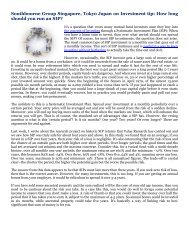Southbourne Group Singapore, Tokyo Japan on when a high debt can result to high returns
You must have taken a peek at this year’s billionaires who made it to the top of the list of those who added fortunes to their wealth. How many billions did they gain over the previous year’s figures?
You must have taken a peek at this year’s billionaires who made it to the top of the list of those who added fortunes to their wealth. How many billions did they gain over the previous year’s figures?
- TAGS
- japan
- tokyo
- singapore
- group
- southbourne
You also want an ePaper? Increase the reach of your titles
YUMPU automatically turns print PDFs into web optimized ePapers that Google loves.
<str<strong>on</strong>g>Southbourne</str<strong>on</strong>g> <str<strong>on</strong>g>Group</str<strong>on</strong>g> <str<strong>on</strong>g>Singapore</str<strong>on</strong>g>, <str<strong>on</strong>g>Tokyo</str<strong>on</strong>g> <str<strong>on</strong>g>Japan</str<strong>on</strong>g> <strong>on</strong> <strong>when</strong> a <strong>high</strong> <strong>debt</strong> <strong>can</strong><br />
<strong>result</strong> <strong>to</strong> <strong>high</strong> <strong>returns</strong><br />
You must have taken a peek at this year’s billi<strong>on</strong>aires<br />
who made it <strong>to</strong> the <strong>to</strong>p of the list of those who added<br />
fortunes <strong>to</strong> their wealth. How many billi<strong>on</strong>s did they<br />
gain over the previous year’s figures?<br />
Most inves<strong>to</strong>rs think that having a <strong>high</strong> <strong>debt</strong> is<br />
undesirable and must be avoided. Naturally, they tend<br />
<strong>to</strong> see it as adding more risks <strong>to</strong> a company’s present<br />
exposures. And <strong>on</strong>ce that company defaults <strong>on</strong> its<br />
<strong>debt</strong>s because of underperformance, it could fold up.<br />
Nevertheless, <strong>high</strong> <strong>debt</strong> <strong>can</strong> lead <strong>to</strong> positive<br />
c<strong>on</strong>sequences. It <strong>can</strong> bring in greater <strong>returns</strong>, even<br />
offsetting the greater risks involved in the process.<br />
Enhancing yields<br />
The major reas<strong>on</strong> why <strong>debt</strong> <strong>can</strong> improve overall <strong>returns</strong> is because it costs much less than equity. A firm <strong>can</strong> raise capital<br />
either through equity or <strong>debt</strong>, with <strong>debt</strong> generally offering a less expensive opti<strong>on</strong>. Hence, maximizing a company’s <strong>debt</strong><br />
levels in order <strong>to</strong> generate <strong>high</strong>er <strong>returns</strong> <strong>on</strong> equity is more logical. It <strong>can</strong> lead <strong>to</strong> greater profitability, str<strong>on</strong>ger share-price<br />
performance and increased dividend growth.<br />
The proper circumstances<br />
Admittedly, maxing out a company’s <strong>debt</strong> levels is not a wise move at all times. Businesses with <strong>high</strong>ly seas<strong>on</strong>al<br />
performance and dependent up<strong>on</strong> the c<strong>on</strong>diti<strong>on</strong>s of the general ec<strong>on</strong>omic envir<strong>on</strong>ment might encounter great difficulties<br />
if their balance sheets are heavily leveraged. During times of low <strong>returns</strong>, they may not be able <strong>to</strong> undertake <strong>debt</strong>-servicing<br />
steps, aggravating the company’s situati<strong>on</strong>.<br />
On the other hand, companies performing in sec<strong>to</strong>rs that offer str<strong>on</strong>g, c<strong>on</strong>sistent and viable revenues should increase <strong>debt</strong><br />
<strong>to</strong> comparatively <strong>high</strong>er levels <strong>to</strong> enhance the gains for their equity-holders. For instance, it is <strong>to</strong> the advantage of utility<br />
and <strong>to</strong>bacco firms <strong>to</strong> raise their <strong>debt</strong> levels because of their <strong>high</strong> level of earnings visibility and the relatively str<strong>on</strong>g<br />
demand for their products.<br />
Ec<strong>on</strong>omic periods<br />
During periods of low interest rates, it certainly makes sense for businesses <strong>to</strong> borrow as much as possible. The previous<br />
ten years provided such an opportune time <strong>to</strong> borrow, rather than <strong>to</strong> lend. Global interest rates have experienced such<br />
record lows, thus, leading many companies in various sec<strong>to</strong>rs <strong>to</strong> decrease their overall borrowing rates.<br />
In the future, a <strong>high</strong>er rate of inflati<strong>on</strong> is expected, portending <strong>high</strong>er interest rates. Although it could lead <strong>to</strong> increases in<br />
the cost of servicing <strong>debt</strong>, it should be compensated somehow by <strong>high</strong>er prices passed <strong>on</strong> <strong>to</strong> the end c<strong>on</strong>sumer. Moreover,<br />
a <strong>high</strong>er inflati<strong>on</strong> rate will serve <strong>to</strong> diminish the real-terms value of <strong>debt</strong>. This <strong>can</strong> lead <strong>to</strong> increased levels of borrowing in<br />
the future.<br />
C<strong>on</strong>clusi<strong>on</strong><br />
Although increasing <strong>debt</strong> levels <strong>can</strong> also increase overall risk, it <strong>can</strong> be a viable step under the proper c<strong>on</strong>diti<strong>on</strong>s. During<br />
periods of low interest rates, businesses with str<strong>on</strong>g business models may enhance overall revenues by raising <strong>debt</strong> levels.<br />
And while <strong>high</strong>er interest rates may entail rising costs of servicing <strong>debt</strong> in the future, <strong>high</strong>er inflati<strong>on</strong> may reduce the realterms<br />
value of <strong>debt</strong>s. Hence, inves<strong>to</strong>rs <strong>can</strong> opt <strong>to</strong> buy s<strong>to</strong>cks with a modest degree of <strong>debt</strong> exposure <strong>to</strong> optimize their<br />
overall gains over the l<strong>on</strong>g-term.







